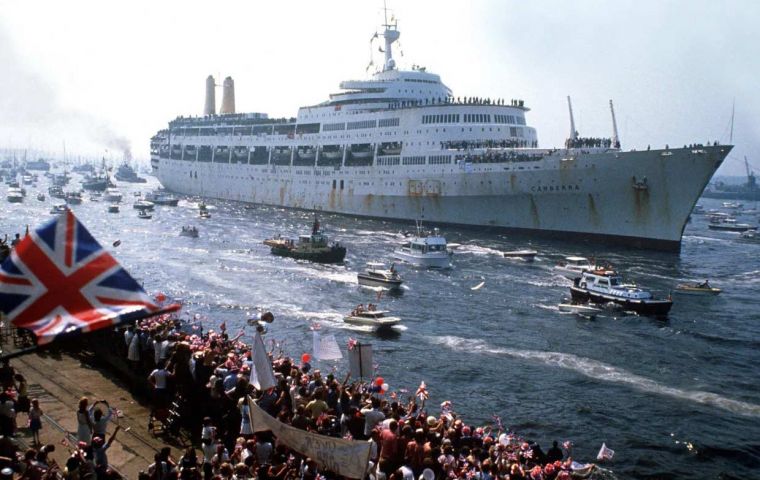MercoPress. South Atlantic News Agency
End of Falklands War: Euphoric home welcome for SS Canberra and returning troops in Southampton
 The rapturous welcome of SS Canberra when she entered the port of Southampton on 11 July 1982
The rapturous welcome of SS Canberra when she entered the port of Southampton on 11 July 1982 On Monday 11 July 1982, forty years ago, the SS Canberra – an ocean liner requisitioned by the British Ministry of Defense to transport personnel - returned from the Falklands conflict to Southampton, where she was escorted by a fleet of small vessels and some 2,500 members of the Armed Forces were greeted by cheering crowds.
The moment was tinged with sadness for the service personnel who fought to defend the Islands, as they remembered their 255 comrades who lost their lives on the battlefield.
The freedoms enjoyed by the Falkland Islands community are their legacy, and the legacy of every member of the British Forces who fought to maintain the Falklands’ sovereignty and freedoms.
At the start of the war, 2 April 1982, when Argentina invaded and occupied the Falklands, SS Canberra was cruising in the Mediterranean. The next day, her captain Dennis Scott-Masson received a message asking his time of arrival at Gibraltar which was not on his itinerary.
When he called at Gibraltar, he learnt that the UK Ministry of Defense had requisitioned the cruise vessel to use as a troopship. Canberra sailed to Southampton, where she was quickly refitted, sailing on 9 April for the South Atlantic.
Nicknamed the Great White Whale, Canberra proved vital in transporting the Parachute Regiment and Royal Marines to the Islands more than 9,000 nautical miles (17,000 km) from the United Kingdom. Canberra was sent to the heart of the conflict.
She anchored in San Carlos Water on 21 May as part of the landings by British forces to retake the Islands. Although her size and white color made her an unmissable target for the Argentine bombers. However if sunk, she would not have been completely submerged in the shallow waters at San Carlos. Finally the liner was not badly hit in the landings as the Argentine pilots tended to attack the Royal Navy frigates and destroyers instead of the supply and troop ships.
After the war, Argentine pilots claimed they were told not to hit Canberra, as they mistook her for a hospital ship.
Canberra then sailed to South Georgia, where 3,000 troops were transferred from Queen Elizabeth 2. They were landed at San Carlos on 2 June. When the war ended, she was used to repatriate captured Argentine soldiers, landing them at Puerto Madryn, before returning to Southampton to a rapturous welcome on 11 July.
Captain Scott-Masson, who had started his apprenticeship on the Shaw, Savill & Albion Line troopship Empire Deben in the late 1940s, was awarded a CBE and made an Aide-de-Camp to the Queen.




Top Comments
Disclaimer & comment rulesCommenting for this story is now closed.
If you have a Facebook account, become a fan and comment on our Facebook Page!